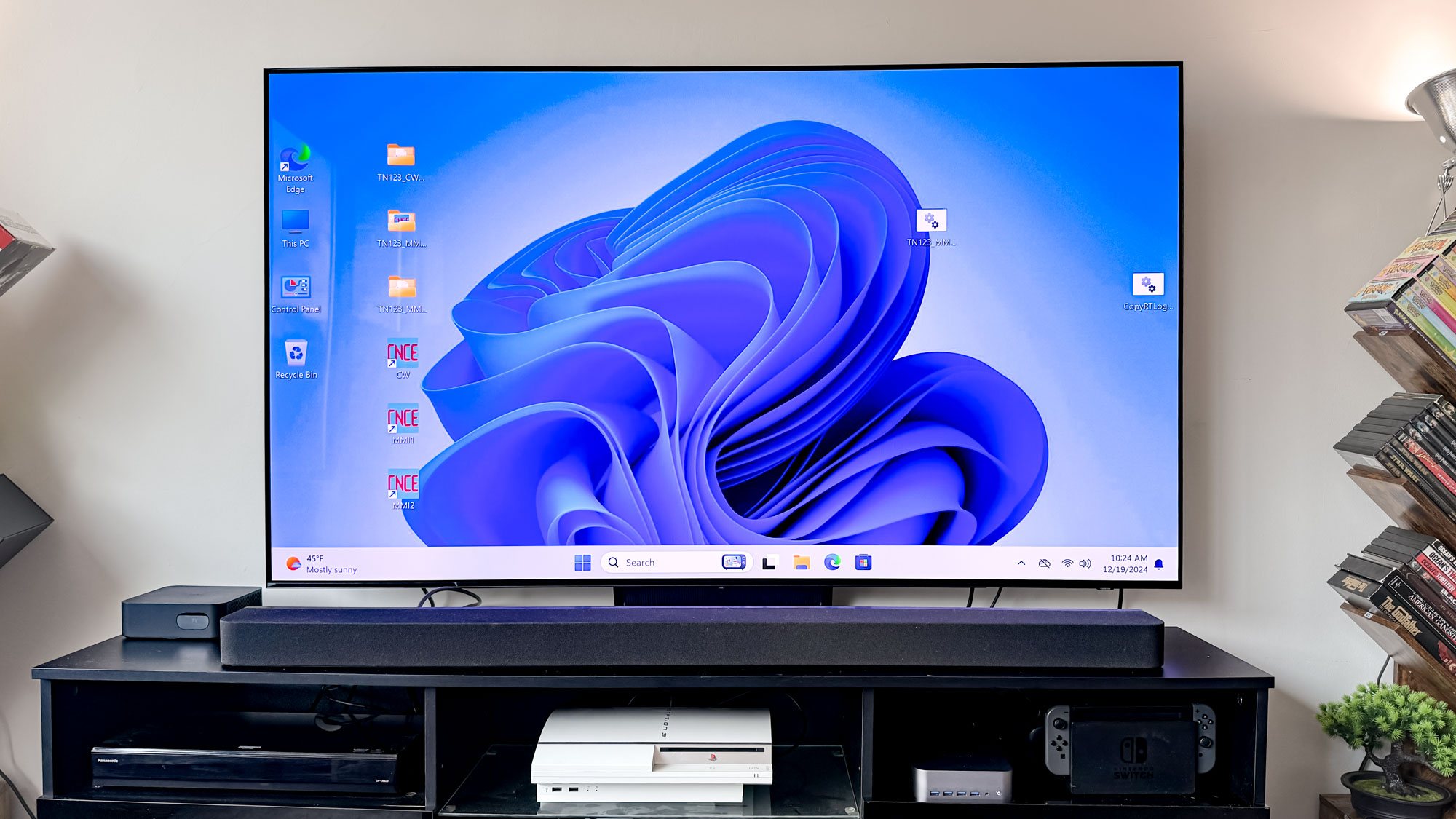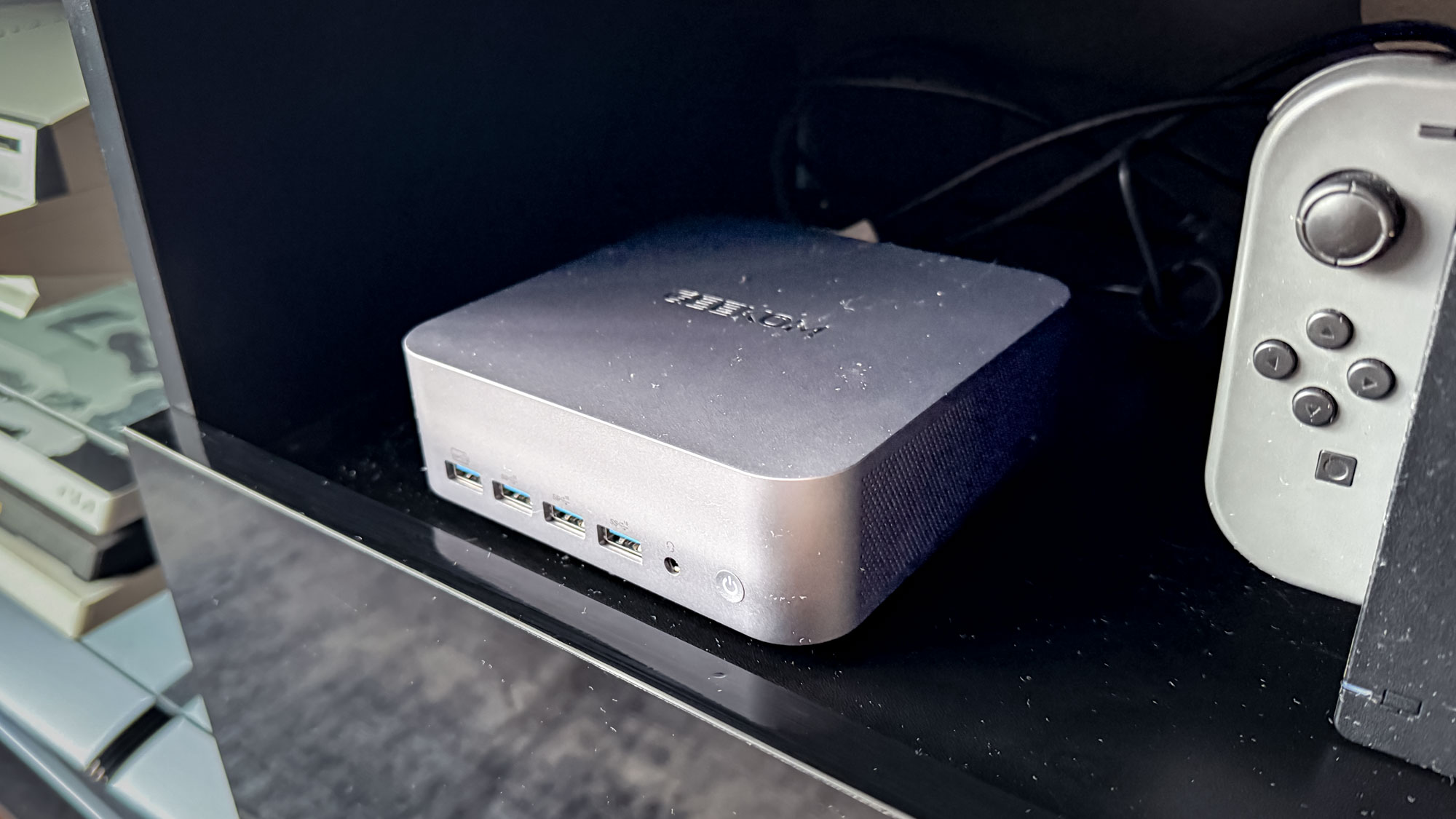
I have a problem. I love gaming, especially on one of the best gaming PCs. There's nothing quite like the unbridled freedom PC gaming allows. Unfortunately, my PC isn't situated close to my main entertainment setup — and who wants to sit at their desk to game after several hours of working at that very spot?
That's why I paired the Geekom GT1 Mega (was $1,299 now $899 on Amazon) with Samsung's S90D 4K OLED TV. I wanted not only to test the viability of using a Mini PC with a 4K TV but to also see if using a PC with a TV has certain benefits over something like a streaming device. We tend to get lost in the confusion of so many varied connected devices it's often hard to choose which is the right one for us, which is where the wide-sweeping potential of a Mini PC steps into frame.
Of course, it won't be a foolproof system. When it comes to 4K resolution, even some of the best PCs bar none can't perform well in triple A gaming or multitasking let alone a Mini PC with half or even less the performance offered on a conventional desktop. You'd be hard-pressed to find a Mini PC capable of gaming at higher frames in 4K, as even the Nvidia GeForce RTX 4090 struggles in certain scenarios.
But I'm not here to push PC gaming to new heights on 4K TVs. I wanted to see if it was feasible to replace a conventional desktop PC with a smaller, more compact option and denote some key findings in using such hardware with a 4K display. The experience isn't foolproof and more than most will undoubtedly want to stick with their current-gen console, but there's something to be said about the viability of pairing a Mini PC with a 4K TV — and it all comes down to the endless potential.
PC gaming on the big screen

As already mentioned, the biggest draw for me in using a Mini PC with a 4K TV was unbridled gaming. The PS5, PS5 Pro, and Xbox Series X/S all max out at 4K/120Hz via VRR, but a Mini PC has no limits. That means, so long as the internals are up to par, the Mini PC could theoretically play games maxed at 4K at 144Hz, but that would be overkill and probably would run very poorly.
This is why I recommend dropping the base resolution down from 4K to something like 1440p or even 1080p. You don't necessarily have to do this, but I'd be willing to bet your Mini PC won't be able to handle games in 4K. You could always keep the base resolution at 4K and individually change the resolution in each game, but that becomes rather tedious and you might have better performance in 1440p depending on the title.
You'll also want to play around with the graphics settings in most games. Depending on your Mini PC and the game in question, even 1080p at max settings might not be in the cards. I mostly played modded FromSoftware titles in Dark Souls 3, Armored Core 6, and Elden Ring, plus I also gave the more graphically-intensive Sand Land a run for its money, as well.
I ran into no issues in my gaming exploits. What made the Mini PC particularly intriguing for me was its handling of modded games in 4K, which to be expected didn't go too well. Older games ran at okay speeds, but more modern experiences like Elden Ring and Armored Core proved to chug tremendously in higher resolutions. That's not too much of an issue, as the S90D OLED TV I'm using will upscale the content to 4K anyway, but you will want to be aware of your PC's base resolution output and adjust this accordingly.

What's nice about PCs is you can play with perspective. Whether you're running Windows in 1080p or 4K, you can fine tune the scale so you're never squinting at your work. This is what made all the difference when I tried video editing workloads on the 4K S90D and it certainly chugged. Mini PCs aren't built for such high-intensive workloads, especially in 4K resolution, but the GT1 handled it pretty well and, despite looking rather odd on a 65-inch display, PC-based video editing never was so crisp and gorgeous.
Of course, in terms of everyday content streaming you won't have any major concerns there. The Geekom GT1 Max, along with many other options among the best Mini PCs and beyond, can handle 4K streaming without breaking a sweat. Plus, the more streamlined and enhanced networking capabilities found on a Mini PC make it that much easier to tweak your experience where necessary.
Yet, despite my ample fun playing such awesome mods as Elden Ring The Convergence and Armored Core 6 Armoury, using a Mini PC with a 4K TV isn't a foolproof system by any means.
The big kickers

If you're considering getting a Mini PC over one of the best streaming devices, you might want to stick with the latter. While I've generally enjoyed my experience using the GT1 Mega, not everyone has nearly $1,000 to spend on a 4K-ready Mini PC. And even if you were, there are several drawbacks you'll have to consider when using such a device or even a desktop PC paired with a 4K TV.
One of the biggest downsides of going this route mirrors a major gripe of mine after I replaced my PC monitor with the LG C4 OLED — no CEC, otherwise known as Consumer Electronics Control. Essentially, this means I can't turn the Mini PC on when booting up the TV or vice versa, a common feature found on several streaming devices and major gaming consoles.
There are some workarounds for this issue, namely CEC-compliant HDMI adapters. These aren't foolproof, though, and could have unintentional setbacks on image quality, gaming performance, or any number of assorted issues not bound to the Mini PC in particular. And if that wasn't enough, you also have to contend with traditional PC navigation, necessitating the need to always have a mouse and keyboard by your home entertainment setup.
These are fundamental issues with user experience and usability, but then you also open up the can of worms that is HDR compatibility. Your Mini PC most likely won't come equipped with specific HDR support — and worse still, no Dolby Atmos either.
These are just some of the ways using a Mini PC might not be in your best interest. But if you're willing to live with these setbacks and want a change of pace, pairing your 4K TV with a Mini PC could do wonders.







